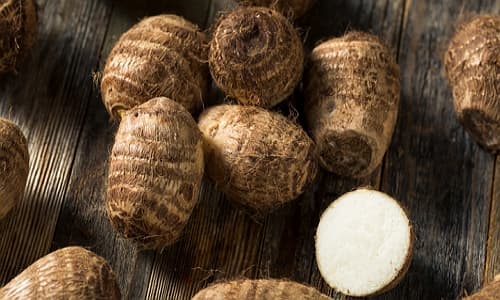Taro Root Benefits, Season, Side Effects
Taro Root Nutrition

| Taro Root (100g) Nutrition | |||
| Carbohydrate | Protein | Fat | Calories |
| 14g | 2.3g | 0.3g | 130kcal |
| Main Nutrition | Potassium, dietary fiber, vitamin A | ||
| Main Benefits | Promotes digestive health, regulates blood sugar | ||
| Side Effects | Excessive intake may cause indigestion, abdominal pain, and kidney stones. | ||
Taro Root is a vegetable used in a variety of cuisines around the world. It has a slightly sweet taste and a texture similar to a potato. Its nutritional benefits make it a healthier food than other root vegetables such as potatoes. Taro Root is rich in nutrients that may provide important health benefits. Taro Root’s high levels of vitamins may also promote healthy vision, skin, blood circulation, and immune system function.
Taro Root Benefits
1. Blood sugar control
Taro contains two types of carbohydrates that are beneficial for blood sugar management: fiber and resistant starch. Fiber is a carbohydrate that humans cannot digest. Because it is not absorbed, it does not affect blood sugar levels. It also slows the digestion and absorption of other carbohydrates, preventing blood sugar spikes after a meal. Taro Root also contains a special type of starch known as resistant starch, which humans cannot digest and therefore does not raise blood sugar levels.
📃How much does Taro Root actually affect diabetes?
2. Anticancer effect
Taro Root contains plant-based compounds called polyphenols, which have a variety of health benefits, including reducing the risk of cancer. The main polyphenol found in Taro Root is Quercetin. Quercetin can cause cancer cell death and slow the growth of several types of cancer. It is also a powerful antioxidant that protects the body from excessive free radical damage associated with cancer.
3. Gastrointestinal health
Taro Root is rich in fiber and resistant starch, which may benefit gut health. Your body doesn’t digest or absorb fiber and resistant starch, so they remain in your intestines. Once it reaches the colon, it becomes food for gut microbes and promotes the growth of good bacteria. This may help prevent inflammatory bowel diseases such as ulcerative colitis and colon cancer.
4. Heart Health
Taro Root is a heart-healthy addition to your diet. Fiber intake is not only associated with a reduced risk of coronary heart disease, but may also help lower blood pressure and cholesterol levels, which are major risk factors for heart disease. It’s also rich in antioxidants, beneficial compounds that help fight free radical damage and prevent disease. Increasing your intake of antioxidants can reduce inflammation and oxidative stress, which may contribute to the prevention of heart disease and atherosclerosis, or fatty plaque buildup in the arteries.
Taro Root harvest time
Taro Root Side Effect
- Taro Root contains calcium oxalate, which can numb the tongue or cause poisoning if eaten raw.
- People with weak digestive systems may experience symptoms such as indigestion, abdominal pain, diarrhea, etc. if they consume too much Taro Root.
- Taro Root contains lime oxalate, which may cause stones if consumed in excessive amounts. It is recommended to consume approximately 200g per day.
- It is recommended to wash it under running water and soak it in rice water to remove toxicity and use it for cooking.